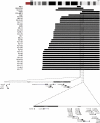CADM1 is a strong neuroblastoma candidate gene that maps within a 3.72 Mb critical region of loss on 11q23
- PMID: 18559103
- PMCID: PMC2442116
- DOI: 10.1186/1471-2407-8-173
CADM1 is a strong neuroblastoma candidate gene that maps within a 3.72 Mb critical region of loss on 11q23
Abstract
Background: Recurrent loss of part of the long arm of chromosome 11 is a well established hallmark of a subtype of aggressive neuroblastomas. Despite intensive mapping efforts to localize the culprit 11q tumour suppressor gene, this search has been unsuccessful thus far as no sufficiently small critical region could be delineated for selection of candidate genes.
Methods: To refine the critical region of 11q loss, the chromosome 11 status of 100 primary neuroblastoma tumours and 29 cell lines was analyzed using a BAC array containing a chromosome 11 tiling path. For the genes mapping within our refined region of loss, meta-analysis on published neuroblastoma mRNA gene expression datasets was performed for candidate gene selection. The DNA methylation status of the resulting candidate gene was determined using re-expression experiments by treatment of neuroblastoma cells with the demethylating agent 5-aza-2'-deoxycytidine and bisulphite sequencing.
Results: Two small critical regions of loss within 11q23 at chromosomal band 11q23.1-q23.2 (1.79 Mb) and 11q23.2-q23.3 (3.72 Mb) were identified. In a first step towards further selection of candidate neuroblastoma tumour suppressor genes, we performed a meta-analysis on published expression profiles of 692 neuroblastoma tumours. Integration of the resulting candidate gene list with expression data of neuroblastoma progenitor cells pinpointed CADM1 as a compelling candidate gene. Meta-analysis indicated that CADM1 expression has prognostic significance and differential expression for the gene was noted in unfavourable neuroblastoma versus normal neuroblasts. Methylation analysis provided no evidence for a two-hit mechanism in 11q deleted cell lines.
Conclusion: Our study puts CADM1 forward as a strong candidate neuroblastoma suppressor gene. Further functional studies are warranted to elucidate the role of CADM1 in neuroblastoma development and to investigate the possibility of CADM1 haploinsufficiency in neuroblastoma.
Figures


References
-
- Weiss WA, Godfrey T, Francisco C, Bishop JM. Genome-wide screen for allelic imbalance in a mouse model for neuroblastoma. Cancer Res. 2000;60:2483–2487. - PubMed
-
- Trochet D, Bourdeaut F, Janoueix-Lerosey I, Deville A, de Pontual L, Schleiermacher G, Coze C, Philip N, Frebourg T, Munnich A, Lyonnet S, Delattre O, Amiel J. Germline mutations of the paired-like homeobox 2B (PHOX2B) gene in neuroblastoma. Am J Hum Genet. 2004;74:761–764. doi: 10.1086/383253. - DOI - PMC - PubMed
-
- van Limpt V, Schramm A, van Lakeman A, Sluis P, Chan A, van Noesel M, Baas F, Caron H, Eggert A, Versteeg R. The Phox2B homeobox gene is mutated in sporadic neuroblastomas. Oncogene. 2004;23:9280–9288. - PubMed
Publication types
MeSH terms
Substances
LinkOut - more resources
Full Text Sources
Medical
Miscellaneous

